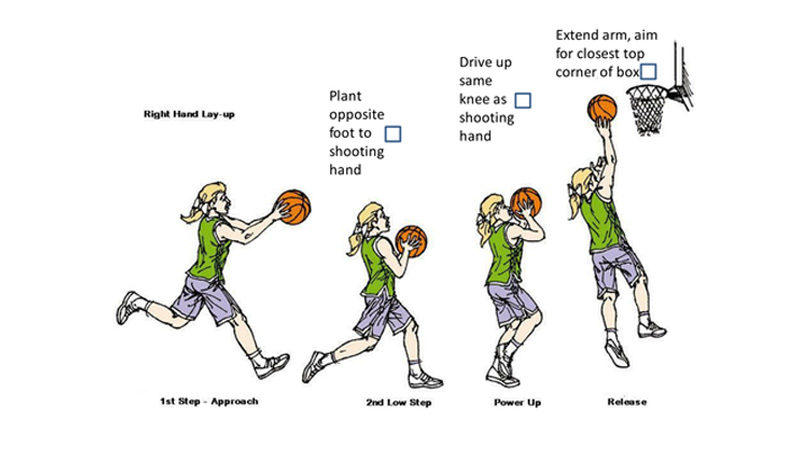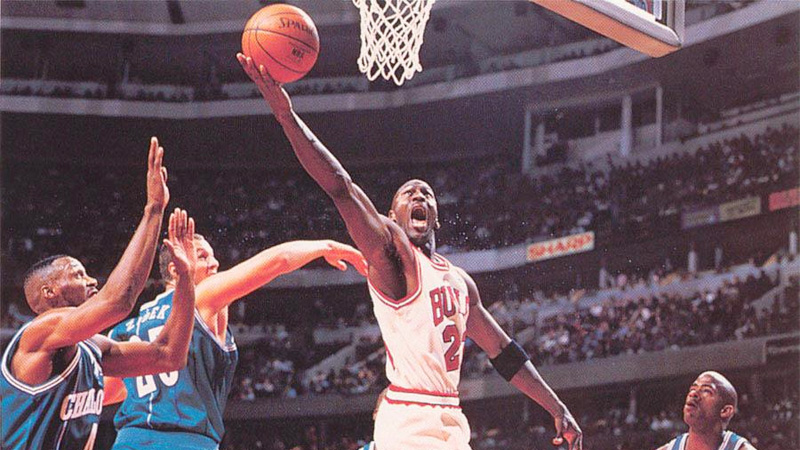Welcome to our blog post on the fundamental basketball skill of layups! If you’re new to the game or looking to refine your technique, understanding how many steps you can take for a layup is crucial.
A layup is a fundamental basketball shot taken near the basket, and knowing the rules regarding footwork can make a significant difference in your performance on the court.
In this article, we’ll explore the rules governing layup footwork and provide answers to some frequently asked questions to help you become a more effective player. So, let’s lace up our sneakers and get ready to take your layup game to the next level!
What Is Layup in Basketball?
In basketball, a layup is a fundamental and crucial offensive move used by players to score points close to the basket. It involves driving toward the hoop and gently laying the ball into the net using one hand or both hands.
The objective of a layup is to avoid defenders and finish the shot as efficiently as possible, maximizing the chance of scoring. Layups are essential in basketball as they offer a high-percentage scoring opportunity, especially when players are positioned close to the basket.
Mastering the layup is one of the first skills aspiring basketball players learn, and even professional players continually work on improving their layup techniques.
How Many Steps Can You Take For a Layup?

Source: fanatics
In the dynamic world of basketball, the rules surrounding layups add an intriguing layer of excitement to the game. When it comes to executing a layup, players must adhere to a fundamental rule: they are generally allowed to take two steps after gathering the ball.
These two steps are essential for propelling them toward the basket, presenting a thrilling challenge of speed, precision, and agility.
Gather and Drive: The Initial Burst of Energy
As the player begins their approach to the basket, they must first gather the ball in their hands. This initial step marks the beginning of their offensive maneuver.
With a burst of energy, they dribble toward the hoop, closely guarded by defenders who are determined to thwart their progress. This moment is a crucial test of the player’s quickness and ability to control the ball amidst the chaos of the court.
One Step, Two Steps: The Dance of Footwork
As the player gains ground toward the hoop, they expertly plant their penultimate foot, a split-second before their final step.
This sequence is a mesmerizing dance of footwork, as players must carefully calculate the perfect moment to execute their last two steps before making their move to the rim.
These two steps grant them the necessary momentum to elevate toward the basket and overcome the challenges presented by towering defenders.
The Release: An Artful Finesse
The climax of the layup is the release, where the player unleashes the ball with an artful finesse. In this fleeting moment, they must summon all their focus and precision to softly guide the ball into the hoop, avoiding the outstretched arms of defenders.
The release is a beautiful symphony of touch and control, often leaving spectators in awe as the ball gracefully glides through the net.
The Limit: Avoiding the Travelling Violation
As in any art form, rules play a crucial role in maintaining the integrity of the game. Basketball’s rulebook dictates that after the second step, the player must promptly release the ball to avoid a traveling violation.
Exceeding the two-step limit will result in the ball being turned over to the opposing team, a consequence that keeps players on their toes and demands utmost adherence to the rules.
The Eurostep: A Dazzling Exception
Among the arsenal of moves in a player’s repertoire, the Eurostep stands as a dazzling exception to the standard two-step rule.
During the Eurostep, a player masterfully deceives defenders by taking an initial step in one direction and then seamlessly transitioning into a second step in a different direction before releasing the ball.
This acrobatic move adds an element of surprise to the player’s approach, leaving defenders momentarily befuddled and providing a unique opportunity to navigate through tight defensive coverage.
How to Do Layups Properly?

Source: wakelet
Executing a layup properly requires a combination of speed, coordination, and finesse, making it a skill that demands practice and refinement. Here’s a step-by-step guide on how to perform a layup correctly:
Footwork
Approach the basket at a comfortable pace, dribbling the ball with your dominant hand. As you get closer to the hoop, take your penultimate step (second-to-last step) with your non-dominant foot, generating momentum toward the basket.
This footwork allows you to explode toward the hoop with greater power and control.
Gather the Ball
Just before taking your last step, gather the ball in both hands to prepare for the shot. Bring the ball close to your body, protecting it from defenders. This phase of the layup is crucial as it prevents opponents from swiping the ball away and sets you up for a smooth shot release.
Jumping and Shooting
Push off your penultimate foot and jump explosively towards the hoop. Extend your shooting arm towards the basket, releasing the ball with a soft touch of your fingertips.
Aim to place the ball off the backboard or directly into the net. The shooting motion should be fluid and controlled, ensuring a higher chance of the ball finding its mark.
Body Positioning
Keep your body squared towards the basket to ensure accuracy. Use the opposite hand of your shooting hand to shield the ball from defenders and maintain balance in the air.
Maintaining proper body positioning prevents defenders from altering your shot and increases your chances of scoring despite defensive pressure.
Follow Through
After releasing the ball, follow through with your shooting hand, maintaining a smooth motion toward the target. This follow-through helps improve shooting accuracy and control over the trajectory of the shot.
Additionally, it ensures that you maintain proper form and reduces the chance of any last-minute adjustments that could affect the shot’s outcome.
Significance of Layups in Basketball
Layups hold immense significance in basketball due to several reasons, making them an essential skill for players of all positions:
High-Percentage Shot
Layups are close-range shots, offering a higher probability of success compared to shots taken from a distance. This makes them a reliable scoring option for players, especially in critical game situations.
Fast Breaks and Transition Offense
In fast-break situations or transition offenses, players can quickly drive to the hoop for a layup before the defense has a chance to set up. This swift and efficient scoring method can lead to crucial points and momentum swings during a game.
Drawing Fouls
Players driving for a layup are often fouled by defenders attempting to stop the shot. This leads to free-throw opportunities, allowing teams to score even when the layup is not successful. Capitalizing on free-throw opportunities can significantly impact the game’s outcome.
Building Confidence
Successfully making layups boosts a player’s confidence and provides positive momentum for more challenging shots throughout the game. Consistently converting layups reinforces a player’s belief in their abilities, leading to better overall performance.
Challenges of Layups in Basketball
While layups offer numerous advantages, they also come with some challenges that players must overcome to become effective scorers:
Defensive Pressure
Layups often require players to navigate through tight defensive coverage, making it challenging to find an open path to the hoop. Developing quick decision-making and agility is vital to maneuvering around defenders and finishing the shot.
Shot Blocking
Defenders can use their height and jumping ability to block layup attempts, forcing players to develop creative finishing techniques. Learning to use the backboard effectively and adapting to defenders’ movements is crucial in overcoming shot blockers.
Contact and Physicality
Players attempting layups frequently face physical contact from defenders, making it essential to maintain focus and composure while shooting. Developing strength and balance can help absorb contact and finish shots in challenging situations.
Ambidexterity
Scoring consistently with both hands is crucial for successful layups, which can be challenging for players who favor their dominant hand. Practicing with both hands is essential to become a well-rounded player and makes scoring unpredictable for defenders.
Eurostep Timing
Executing the Eurostep effectively demands precise timing and coordination, as mistiming the steps can lead to traveling violations. Players must practice this move extensively to master its intricacies and use it as an effective weapon against defenders.
FAQs
How many steps are allowed for a layup in basketball?
In basketball, you are generally allowed to take two steps when performing a layup. These steps can be taken after gathering the ball while driving to the basket.
The first step occurs when you pick up the ball, and the second step follows. After the second step, you must release the ball toward the basket for the shot.
Can you take more than two steps for a layup?
No, taking more than two steps for a layup is considered a traveling violation in basketball. The rules state that once you gather the ball and take your first step, you are only allowed one more step to complete the layup.
Any additional steps beyond this limit will result in a turnover, and possession of the ball will be awarded to the opposing team.
Are there any exceptions to the two-step rule for a layup?
Yes, there is one notable exception to the two-step rule – the “Eurostep.” The Eurostep is a move commonly used by players to evade defenders and create space for a layup or a close-range shot.
In a Eurostep, a player takes an initial step in one direction and then a second step in a different direction before releasing the ball. It’s essential to note that both steps must be taken in the same direction, and the Eurostep must be executed cleanly, without any additional steps, to avoid a traveling violation.
Can you jump off the wrong foot for a layup?
Yes, it is entirely acceptable to jump off the non-dominant foot for a layup. This move is often referred to as a “wrong-foot layup” or a “reverse layup.” It can be a valuable tool for confusing defenders and finishing shots around the rim with finesse.
Mastering this technique adds versatility to your layup repertoire and can significantly improve your scoring opportunities in the paint.
Is a layup the most efficient shot in basketball?
Yes, the layup is widely considered one of the most efficient shots in basketball. Due to its close proximity to the basket, it has a higher probability of going in compared to more distant shots.
Layups are also typically taken at higher shooting percentages because they involve a player driving to the hoop and attempting a shot while avoiding contested shots from further distances.
Conclusion
Understanding the rules regarding footwork is essential for executing successful layups in basketball. Remember that you are allowed to take two steps after gathering the ball, and any additional steps will result in a traveling violation.
The Eurostep is an exception to this rule, allowing you to take two steps in different directions when performed correctly. Additionally, you can jump off the non-dominant foot for a “wrong-foot layup” to add versatility to your game.
As you continue to develop your basketball skills, mastering the layup is a fundamental step toward becoming a more well-rounded player.







